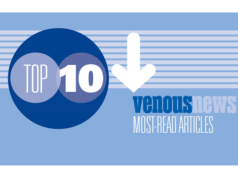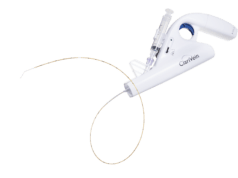This advertorial is sponsored by Merit Medical. A downloadable version can be found here.
In this case series, Michael Tal (Jerusalem, Israel) explains how the ClariVein OC device (Merit Medical) offers a safe treatment option for venous leg ulcers.
Venous leg ulcers are a serious and common disease affecting 1–2% of patients over the age of 70. The disease results in a significant financial and quality-of-life burden. Invasive treatments of the underlying pathology in the long and short saphenous vein enhances the management of advanced venous disease.
Venous ulcers usually occur at the lower calf, often in the area of the medial malleolus. Interventions should include treatment to the lowest point of venous incompetence, which frequently is the area of ulceration. Yet heat-based therapies such as laser and radiofrequency (RF) treatments are usually applied from the level cephalad to the ulcer because of the risk of collateral damage to adjacent nerves.
The ClariVein OC is a device for ablation of the great saphenous vein (GSV) or small saphenous vein (SSV) based on the MOCA concept. MOCA stands for mechanical occlusion chemically assisted. The device contains a handle connected to a small 1mm diameter catheter that contains a rapidly spinning angled tip wire (3500RPM). The operator activates the wire and simultaneously injects sclerosant (polidocanol or sodium tetradecyl sulfate). This dual action causes vein spasm and permanent damage to the vessel wall and subsequent occlusion. ClariVein OC is NTNT—non thermal non tumescent technology. This allows it to be used as low as needed, as there is no risk of nerve damage. We have been using it successfully for treatment of venous ulcers at the level of the ulcer.
We have been using the ClariVein OC in treatment of venous ulcers classified as C5 and C6. Our preferred access point was inframalleolar, either into the GSV or the SSV, depending of the locations of the reflux. Reflux was defined in standing duplex ultrasound examination as over 0.5 seconds.
Access was performed with a micro puncture set under ultrasound guidance. The whole procedure was performed through the sheath of the micro puncture set (Figure 1).

The GSV or SSV were treated all the way from the access point to the highest point available, preferably the saphenofemoral junction (SFJ; Figure 2).

Medication given during the procedure were antibiotics, minimal sedation using oral benzodiazepam, and a sub Q low-molecular-weight (LMW) heparin Clexan 40Mg.
Post procedure the ulcers were bandaged with Paraffin gauze and class 2 (18–22mmHg) stockings were applied.
Outcome measures were pain, ulcer size and healing, leg oedema and recurrence. A total of 64 patients were treated: 48 GSV and 16 SSV.
Pain score was reduced from 5 to 1 one-week post procedure. Leg oedema decreased from 1 to 0.80% of ulcers healed completely within six months. Of those that did not achieve complete healing, all had substantial reduction of ulcers size. No deep vein thrombosis (DVT) or other serious complications were observed.
The saphenous nerve is in close proximity to the vein in the level of the ankle. For that reason, the vein in that level is usually not treated by catheter mediated heat treatments such as laser and RF. In order to achieve the results seen in this paper, direct treatment to the ulcer including the veins directly underneath it is needed. There are many perforators and tribulates in the perimalleolar area. And these are often enlarged and incompetent in cases of venous ulcers. During treatment with the ClariVein OC, ultrasound imaging of the ulcer and the perforators underneath it shows the presence of agitated sclerosant and spasm. It seems that this local affect as well as treatment of the GSV and SSV underneath the ulcer contribute to the results described in this paper. In addition, importantly, no nerve injury or post procedure paresthesia was encountered in our series.
In conclusion, the ClariVein OC device allows safe treatment of the ulcer and the veins underneath it as low as the ankle. Inframalleolar access is safe and effective. This allowed a high rate of ulcer healing and improvement in the patient’s symptoms.
Michael Tal is cofounder of Vascular Insights and inventor of the ClariVein OC device. He is also an interventional radiologist at Hadassah Hospital in Jerusalem, Israel.
Disclaimer: ClariVein OC is not approved, cleared, or available for sale in the USA. Before using any product, refer to the instructions for use (IFU) for indications, contraindications, warnings, precautions, and directions for use.












